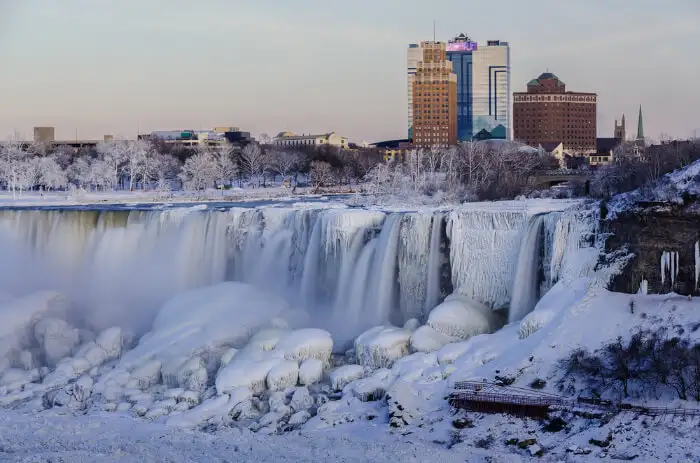Have you ever wondered what it would be like to see Niagara Falls lit up in all its glory? In this blog post, we look at the stunningly beautiful sight of Niagara Falls in Canada, frozen over and illuminated by Night. Discover this Canadian wonder’s mesmerizing beauty and discover what makes it so unique!
Niagara Falls transforms into a frozen wonderland when outside temperatures dip below freezing. The mist from the falls creates an otherworldly scene, and the waterfalls become giant icicles. At Night, the falls are illuminated with colourful lights, making them an even more breathtaking sight.
If you want a unique winter experience, head to Niagara Falls, Canada, at Night. You’ll be able to see the falls in a whole new light and appreciate their beauty differently.
Where to View the Frozen Niagara Falls, Canada, At Night?
If you’re lucky enough to be in Niagara Falls during winter, you can experience the falls in a new way – frozen! Niagara Falls freezes every year, and it’s a sight to behold.
You can view the frozen falls well in a few different places. One option is to take the Journey Behind the Falls tour. This tour takes you right into the heart of the action, where you can see and feel the power of the falls up close. You’ll also see the massive ice formation that forms at the base of the falls each year.
Another excellent spot for viewing the frozen falls is Queen Victoria Park. This park offers panoramic views of the American and Horseshoe Falls, and it’s gorgeous at Night when the falls are illuminated. There are also several restaurants and cafes nearby, so you can grab a bite to eat while you enjoy the view.
Finally, if you’re looking for an even more unique experience, consider taking a helicopter tour of Niagara Falls. These tours give you a bird’s-eye view of the Canadian and American sides of the falls and a chance to see them from above as they cascade over the edge.

Tips for Photographers
As a photographer, one of the most important things you can do is ensure you have the proper equipment. This means having a good tripod, a camera that can handle low light conditions and a fast lens.
Another important tip is to dress warmly! Niagara Falls, Canada, can be icy at Night, and you don’t want to risk getting frostbite.
Finally, it’s always a good idea to bring along a spotter. Someone who can help you find the best angles and ensure you’re not missing anything important.

The Science Behind the Frozen Niagara Falls
During the winter season, when temperatures drop significantly, freezing temperatures can lead to ice formation. This process occurs when water molecules lose heat energy and become solid. Ice formation can impact the environment, affecting water flow in rivers, lakes, and streams.
As freezing temperatures persist, bodies of water may start to freeze over, creating a layer of ice on their surfaces. This ice formation can impede the normal flow of water, potentially causing disruptions in aquatic ecosystems. Additionally, it can affect human activities such as transportation and recreational activities that rely on open bodies of water. The intricate beauty of ice crystals is another fascinating aspect related to freezing temperatures.
Unique and intricate ice crystal formations can occur when water freezes slowly under specific conditions, such as in calm weather patterns with low humidity levels. These delicate formations are often admired for their mesmerizing shapes and patterns.
Understanding winter weather patterns is crucial in predicting when freezing temperatures and subsequent ice formation may occur. Meteorologists analyze factors like air temperature, atmospheric pressure systems, wind patterns, and humidity levels to forecast winter weather conditions accurately.
By comprehending the science behind freezing temperatures, ice formation processes, water flow dynamics influenced by frozen surfaces, and distinctive ice crystal structures formed during cold periods, along with the prediction methods for winter weather patterns, individuals can gain a deeper insight into how these phenomena shape our natural world during wintertime.
The Mesmerizing Illumination
The mesmerizing Niagara Falls, one of the world’s most iconic natural wonders, is a breathtaking sight during daylight and a captivating spectacle after sunset. Thanks to advanced LED technology, the falls are illuminated with an array of vibrant and beautiful coloured lights, creating a stunning light show that enchants visitors from all around the globe.
LED technology has revolutionized nighttime photography at Niagara Falls, allowing photographers to capture its beauty in unprecedented ways. The combination of the falls’ powerful water flow and the vibrant hues emitted by the LED lights creates a truly magical experience worth witnessing firsthand. Whether capturing long exposure shots or experimenting with different angles and perspectives, photographing Niagara Falls at Night provides endless opportunities for creative expression.
The interplay between light and water creates dynamic images that evoke a sense of wonder and awe. Furthermore, besides its aesthetic appeal, the illumination is more than just visual enhancement. It also plays a vital role in raising awareness about environmental conservation.
By utilizing energy-efficient LED technology to illuminate this iconic landmark, efforts are made to minimize ecological impact while offering visitors a captivating experience. So, next time you find yourself near Niagara Falls after dark, witness this incredible display of artistry and technological innovation firsthand. Capture unforgettable moments through your lens or simply immerse yourself in its enchanting atmosphere – either way, you’re bound to create memories that will last a lifetime.
Facts
The falls are located in the Niagara Gorge, one of the most popular tourist destinations in the world. Every year, millions of people visit the falls to see the magnificent waterfalls display.
The falls freeze over in the winter and become a beautiful winter wonderland. The frozen Niagara Falls is a must-see for anyone visiting Canada during the winter months.
There are several ways to view the frozen Niagara Falls. One of the best ways is to take a helicopter tour. Helicopter tours provide a bird’s eye view of the falls and allow you to see them from different angles.
Another great way to view the frozen Niagara Falls is by taking a boat tour. Boat tours take you right up close to the falls so you can see them up close and personal.
If you want an even more unique experience, try ice climbing on the frozen Niagara Falls. This extreme sport is not for everyone, but it’s something you’ll never forget.
Viewing the frozen Niagara Falls from above or below will be an unforgettable experience.
FAQ
Can you walk on frozen Niagara Falls?
Walking on frozen Niagara Falls is not only dangerous but also strictly prohibited. While it may seem tempting to explore the majestic frozen landscape, it is important to prioritize safety and adhere to the regulations set in place by authorities.
The freezing temperatures and unpredictable nature of ice formations make walking on frozen Niagara Falls extremely risky. The ice can be thin, unstable, and prone to sudden cracks or collapses. Additionally, the strong currents beneath the ice pose a significant threat to anyone attempting to walk on it.
Local authorities closely monitor the conditions of Niagara Falls during winter months and take necessary precautions to ensure public safety. Signs, barriers, and enforcement measures are implemented to prevent individuals from venturing onto the frozen falls.
Respecting these regulations and prioritizing personal safety when visiting natural wonders like Niagara Falls is crucial. Instead of risking danger by attempting to walk on frozen surfaces, visitors can enjoy breathtaking views from designated viewing areas or partake in other winter activities offered in the area.
Is Niagara Falls open all Night?
The answer to “Is Niagara Falls open all night?” is yes and no. The falls are always accessible and can be viewed 24/7, as they are a natural phenomenon that operates around the clock. However, access to certain areas and attractions surrounding Niagara Falls may have specific operating hours.
For example, parks and observation decks near the falls typically have designated opening and closing times. These hours may vary depending on the season and weather conditions. It’s important to check with the official website or visitor center for up-to-date information on specific operating hours.
While you may not be able to access certain facilities or attractions at all times of the Night, witnessing Niagara Falls illuminated by colourful lights can be a breathtaking experience after sunset. The falls are lit with vibrant colours that create a mesmerizing display against the dark backdrop.
While some areas around Niagara Falls may have restricted access during nighttime hours, you can still enjoy the beauty of this natural wonder throughout the Night. Remember to check for any updates or restrictions before planning your visit to ensure you make the most of your time at Niagara Falls.
What is the coldest month in Niagara Falls?
The coldest month in Niagara Falls is typically January. During this time, temperatures can drop significantly, with average lows reaching below freezing point. It is important to note that weather patterns can vary yearly, and extreme cold snaps can occur at any time during the winter months. Therefore, visitors should check the current weather forecasts and dress accordingly when planning a trip to Niagara Falls during the colder months.
In January, when the average temperature is -5°C. However, it can sometimes dip below -20 °C, so dress warmly! The falls are still spectacular, even in the cold weather.
How often does Niagara Falls freeze?
The frequency at which Niagara Falls freezes varies from year to year. It largely depends on the weather patterns during the winter months. Typically, when temperatures drop significantly below freezing and remain consistently cold for an extended period, ice formations can be seen along the edges of the falls and in some areas where the water is less turbulent.
Complete freezing of Niagara Falls is rare and has only been documented a few times in history. The last time this happened was in 2022, during a freezing winter. The sight of frozen sections of the falls creates a mesmerizing spectacle that attracts visitors worldwide.
The great Niagara Falls has frozen a few times: 1848, 1911, 1912, 1917, 2014, 2015, and again in 2022.
- Yonge-Dundas Square in Toronto is Now Called “Sankofa Square” - December 17, 2023
- Best Western Brooks’ SureStay Plus debuts in Alberta - December 16, 2023
- Air Canada Arrives in Tulum, Mexico as the First Canadian Airline - December 16, 2023




